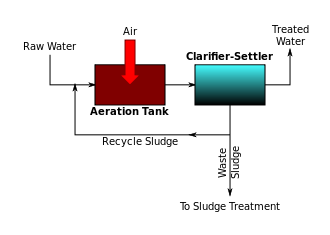Enviraj Consulting
Activated sludge process
| Activated sludge process | |
|---|---|
| Overview | The activated sludge process was developed in England in 1914 and was so named because it involved the production of an activated mass of microorganisms capable of aerobically stabilizing the organic content of a waste. Activated sludge is probably the most versatile of the biological treatment processes capable of producing an effluent with any desired BOD. The process has thus found wide application among domestic wastewater and industrial wastewater treatment. |
 |
|
| How Does it Works |
In activated sludge process wastewater containing organic matter is aerated in an aeration tank in which micro-organisms metabolize the suspended and soluble organic matter. Part of organic matter is synthesized into new cells and part is oxidized to CO2 and water to derive energy. In activated sludge systems the new cells formed in the reaction are removed from the liquid stream in the form of a flocculent sludge in settling tanks. A part of this settled biomass, described as activated sludge is returned to the aeration tank and the remaining forms waste or excess sludge. The main variables of activated sludge process are the mixing regime, loading rate, and the flow scheme. |
| Pollutants Removed | BOD, COD |
| Area of Application | Industrial & Municipal |
| Environmental Footprint | High |
| Area Footprint | High |
| Treatment cost per Cubic Meter | Unknown |
| Capital Cost | Unknown |
| O&M Cost | Low |
| Data Sources: | https://nptel.ac.in/courses/105104102/Lecture%2024.htm |

